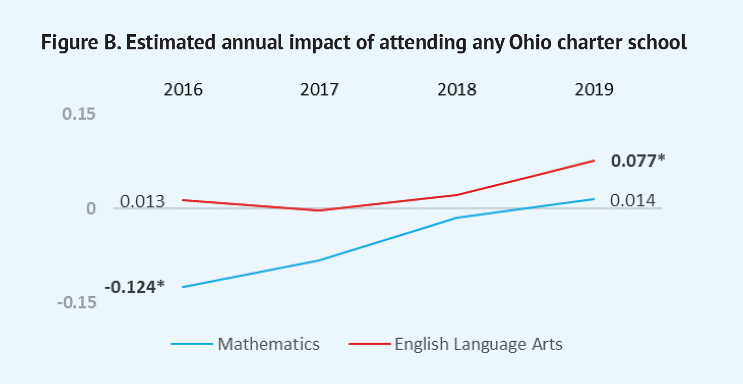This spring, the national education nonprofit EdChoice published a “capstone” report outlining a series of research projects it conducted alongside Hanover Research. The report focuses on open enrollment, a school choice model that allows students to attend public schools other than the one they’re assigned to by their district of residence. As implied by the “capstone” designation, the report offers a sweeping look at open enrollment across the nation, including literature reviews of participation and impacts, detailed case studies of four states (Arizona, Florida, Indiana, and Ohio), and several policy implications.
The report’s introduction offers some important context. It notes that, over the last few decades, public education has experienced a gradual shift away from assigned public schools and toward allowing parents to actively choose a school for their child. This shift has been hastened by “multiple forces,” including growing participation, public support, and innovation in school choice programs. The pandemic also played a part, as it left many parents dissatisfied with their assigned schools and searching for other options. Among the choice options available in most states are charters, magnet schools, virtual schools—and open enrollment.
There are two forms of open enrollment: intra-district, which allows students to transfer from one school to another within their resident district; and inter-district, which allows students to attend a school in a district other than the one in which they live. The first ever statewide open enrollment bill was passed in Minnesota in 1988, and forty-three states now have similar laws. A whopping 86 percent of the nation’s public school students now live in states with inter-district choice programs, and 41 percent live in states where offering open enrollment is mandatory (at least in some cases). Meanwhile, twenty-one states require districts to offer intra-district choice, and seven others have laws that allow districts to choose to participate. At the local level, an increasing number of large urban districts are eliminating attendance zones in favor of intra-district choice programs characterized by unified enrollment systems and a common application for families. And although nailing down participation numbers is tricky, the report suggests that the percentage of public school students participating in inter- or intra-district choice programs could be as high as 3.5 million students, or 7 percent—on par with the number in charter schools.
As for impacts, the report notes that different studies draw different conclusions. This is not surprising, given that policies are distinctive from state to state and district to district. Nevertheless, the report identifies several important conclusions. First, most parents cite school quality as their primary reason for choosing open enrollment, followed closely by school safety and environment, and then proximity to work, home, and daycare. Second, there is a tendency for students from poorly resourced, low-performing schools to transfer to well-resourced, high-performing schools. For example, a 2015 Michigan study found that historically disadvantaged students were most likely to request inter-district transfers, and an analysis from Wisconsin found that low-income districts experienced the highest rates of outmigration. Third, some studies identified evidence of higher academic achievement (Fordham’s 2017 study of Ohio’s program certainly did), while others found achievement to be unchanged or lower. Fourth, students and parents tend to express high rates of satisfaction with their new schools, though parents seem less than thrilled when it comes to transportation (more on this later). Finally, although some studies find that open enrollment policies can result in “greater stratification” by socioeconomic status and race, others find that open enrollment can actually increase diversity in receiving districts. (In Ohio, a 2021 Fordham study found that inter-district open enrollment had virtually no effect on segregation across districts or at the school level.)
The report also offers a more in-depth look at the inter-district open enrollment policies in four states—Arizona, Florida, Indiana, and Ohio. Although each case study is worth a read in its own right, here are a few overarching takeaways.
1.) Arizona and Florida have the least restrictive open enrollment policies. Both states require all public districts to adopt inter- and intra-district policies, which result in widespread school choice options for families. In Florida, districts and charter schools must develop and adopt an open enrollment plan, and they must also define their capacity and clearly post it on their websites.
2.) Indiana and Ohio have more restrictive open enrollment environments for students because districts may opt-out of inter-district open enrollment. Although districts in Indiana and Ohio get to choose whether to accept non-resident students, both states outline certain instances when a district is required to allow inter-district open enrollment. Indianapolis Public Schools, for example, is required to accept both inter- and intra-district transfers.
3.) Transportation is a huge barrier. In all four states, parents and guardians are largely responsible for getting their kids to their chosen school. Unsurprisingly, this can cause a lot of headaches for families.
4.) Although open enrollment can cause equity and access issues, states with voluntary inter-district policies struggle most. In Ohio, most of the affluent and suburban districts that surround the state’s eight major cities refuse to participate in open enrollment. As a result, “public perception generally perceives these suburban districts to be intentionally preventing students from nearby urban centers from enrolling” and therefore “barring access to high-quality education.” Meanwhile, in Indiana, districts were previously allowed to accept or deny students based on criteria like academic achievement, discipline records, and test scores. When a 2013 law prohibited them from continuing to do so, many districts opted to just stop accepting open enrollment transfers.
To accompany this literature review, Hanover conducted in-depth interviews with several district administrators. According to interviewees, open enrollment has positively impacted families and students alike. They reported feeling competitive pressure and often referenced the need to “retain market share” by attracting students from nearby counties. They also noted that many schools have created new or improved existing programs in an effort to retain students, and that districts are consistently using marketing and communication strategies to reach families outside their traditional boundaries. Every interviewee mentioned that open enrollment can make maintaining a “cohesive district system” difficult, not just because these policies can challenge community ties or change neighborhood school identities, but also because fluctuations in demand require constantly managing resources and capacity.
To close, the report covers several policy implications. At the state level, there are five. First, all inter- and intra-district choice programs should be mandatory for school districts. Second, state leaders should consider addressing transportation barriers within policy frameworks, perhaps by reimbursing parents for transporting their children or establishing conveniently located satellite bus stops. Third, open enrollment should be offered to all students, without them needing to meet certain criteria. Fourth, funding flexibility is crucial, as many state funding formulas aren’t designed to permit students to transfer between districts without creating financial disincentives. And finally, if state leaders opt to include capacity provisions, then parents must be able to easily find which schools have open seats. Arizona, Florida, and Oklahoma all require districts to post their open seats by school, grade level, and program, and to update those numbers periodically.
Implications were also included for districts (administrators must remember that transportation can be highly influential, and that school culture and academic programming matter to students), researchers (we need to better understand the potential connection between open enrollment and student achievement), and advocates (identifying and promoting solutions for transportation woes would be huge).
All things considered, it’s clear that open enrollment is a great option for millions of American families. Access to that option, however, largely depends on where a family lives and what school they want to send their child to. There are steps that policymakers, district leaders, and advocates can take to make open enrollment more accessible to more families. But report author Susan Pendergrass says it best: “Equality of opportunity comes not from trying to level the playing field between bureaucratic institutions, but from circumventing the institutions and empowering those whom they serve.”
Source: Susan Pendergrass, “Breaking Down Public School District Lines: Policies, Perceptions, and Implications of Inter-District Open Enrollment,” EdChoice (March 2023).








